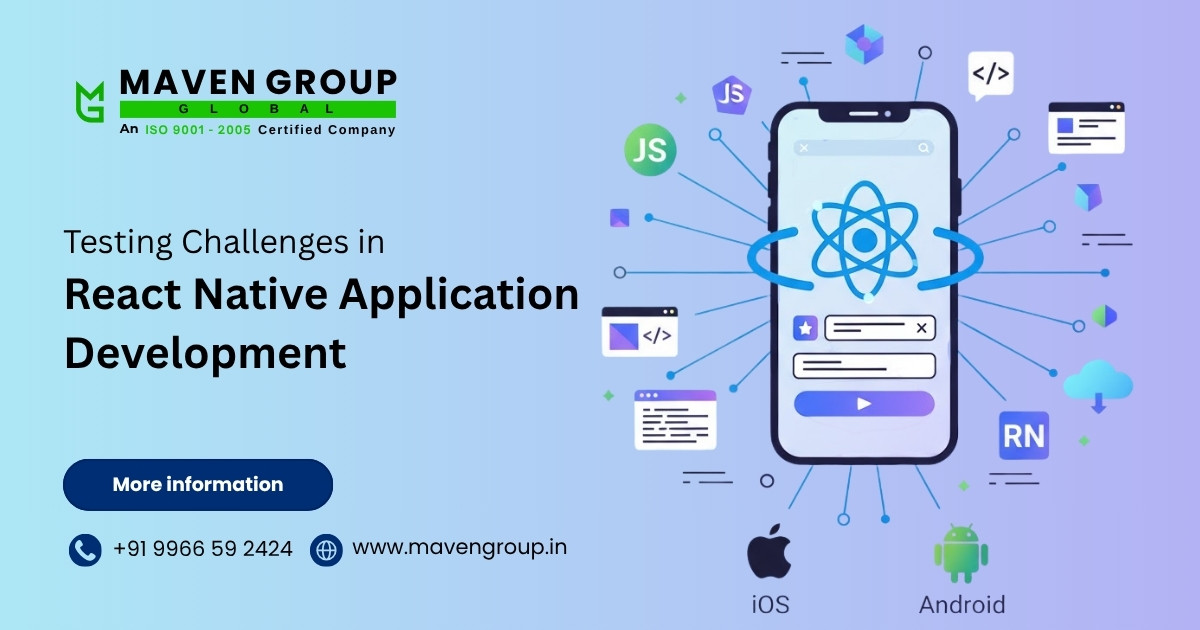React Native remains one of the favorable frameworks for cross-platform mobile application development. It ensures faster development cycles and a unified codebase. However, testing a React Native application may bring numerous challenges to developers and QA teams. Overcoming these challenges is really necessary for delivering reliable and high-performance applications, especially in competitive IT hubs like Hyderabad. Being an App Development Company in Hyderabad, teams must ensure thorough testing to maintain user trust, reduce bugs, and enhance product quality. Below are some common barriers to effective testing in React Native application development, along with practical solutions for each.
Understanding the Testing Landscape in React Native
React Native applications combine JavaScript with native modules. In testing, validation needs to involve UI components, business logic, and behavior on various platforms and different devices. Such flexibility comes at a price, especially in terms of complexity when the apps scale.
Teams such as Maven Group, App Development Company in Hyderabad, trusted names in digital solutions, make it a point to include structured testing as part of development so last-minute failure/production-level defects are avoided.
Common Barriers to Effective Testing in React Native
1. Platform Fragmentation
React Native applications run on both Android and iOS; however, the behaviors, gestures, APIs, and layouts may be different for different platforms.
Challenges:
- Inconsistent layouts or component rendering
- Different system fonts and pixel densities
- Hardware-specific differences include camera, GPS, and sensors.
Solution:
- Cross-platform test tools: Appium and Detox
- Manage device test laboratories or utilize third-party cloud device farms
- Test UI with snapshot testing and automated regression workflows
Any app development company in Hyderabad needs to address device diversity, keeping in mind the diversity of users in every region.
2. Dependencies on Native Modules
Most RN apps rely on native Android/iOS modules for maps, authentication, and notifications, among other sensors. Testing these dependencies can be very complex.
Challenges:
- Unrealistic test results because of missing or mocked native components
- Integration failures during build and deployment
Solution:
- Utilize suitable mocking libraries, such as Jest mocks for native modules.
- Keep documentation of React Native to native SDK version compatibility up-to-date
3. Complexity of Performance Tests
Real-time performance may vary depending on device RAM, OS version, and network quality.
Challenges:
- Memory leaks or UI frame drops identification
- Measuring performance under real-world load
Solution:
- Profiling tools to include: Flipper, Hermes Debugger
- Perform stress and load tests on physical devices
- Performance benchmarks are defined early in the development lifecycle.
A mature app development company in Hyderabad should include performance testing to ensure the seamless experience for users of any type.
4. Limited Resources for Skilled Testing
This requires proficiency in JavaScript, mobile UI testing, and knowledge of platform-specific behaviors, introducing a skill gap that can lead to slower test coverage.
Solution:
- Provide internal training programs for QA teams
- Apply predictable coding patterns – for example, TypeScript + Redux, which provides easier test design
- Cooperate with mature teams that, like Maven Group, retain niche competencies in React Native testing.
Improving React Native Test Outcomes: Best Practices
- Adopt TDD to prevent bugs early.
- Maintaining CI/CD pipelines for automated building and test execution.
- Storybook-based UI-isolation testing of reusable components
- Emphasize testing on real devices instead of emulators for accuracy.
- Document test coverage, test scenarios, and version control testing scripts.
Conclusion
Testing in React Native is no doubt necessary for scalable, secure, high-performance applications; nonetheless, it comes with challenges. Understanding platform fragmentation, the complexity of dependencies, performance issues, and skill gaps will enable teams to design an effective test strategy. Alongside searching for reliable development partners, businesses should reach out for capable teams like Maven Group, an experienced App Development Company in Hyderabad assuring quality through structured testing and optimized development workflows.
Robust testing practices ensure stability in applications, increased user satisfaction, and greater long-term product success, particularly within the fast-changing Hyderabad tech ecosystem.
Question & Answer Section
Q1: How does the use of real devices help in test accuracy?
A: Real devices represent real performance conditions, network variations, touch behaviors, and hardware interactions. In contrast, emulators provide an approximation, while real devices show actual user experiences.
Q2: Can automation fully replace manual testing for React Native apps?
A: No. Automation cuts down on repetitive testing, while manual testing is needed for quality UI, usability validation, and device-specific visual checks.
Q3: How can organizations ensure long-term maintainability in React Native testing?
A: Working with structured teams like Maven Group or a professional App Development Company in Hyderabad ensures proper version control, automation strategy, and scalable testing workflows.







 Website Development
Website Development App Development
App Development E-Commerce Web & Apps
E-Commerce Web & Apps Customized Application
Customized Application CRM Development
CRM Development ERP Development
ERP Development Search Engine Optimization
Search Engine Optimization Search Engine Marketing
Search Engine Marketing Social Media Marketing
Social Media Marketing Graphic Design
Graphic Design Content Development
Content Development Marketing Analysis
Marketing Analysis Staff Augmentation Services
Staff Augmentation Services Recruitment Process Outsourcing
Recruitment Process Outsourcing